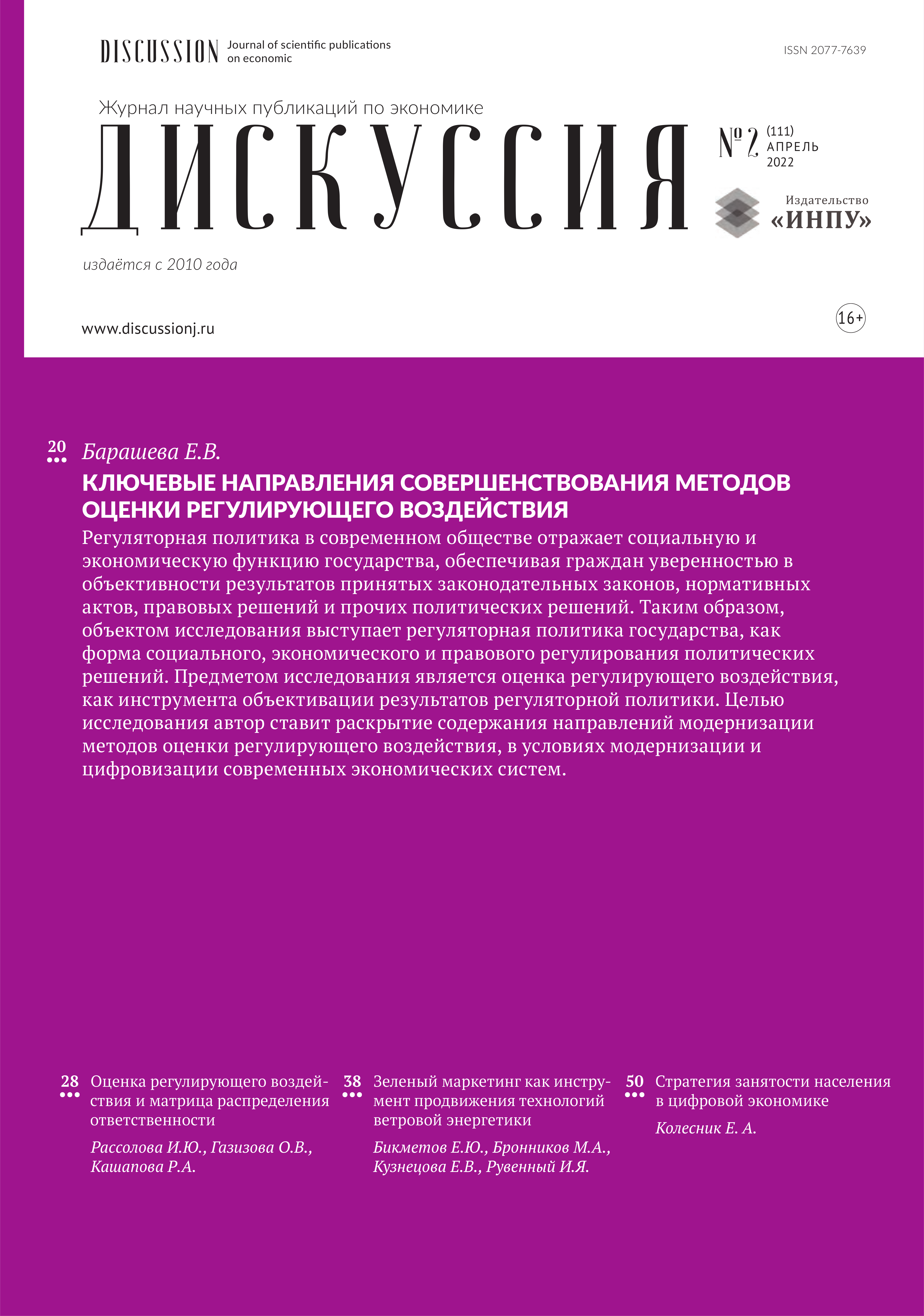Spatial-compositional assessment and prediction of the corporate state of organizations in the copper sub-industry in the conditions of the new economic reality
Keywords:
Complex analysis, influence of the external environment, assessment of the state of the internal environment, activity forecasting, balanced-empirical mechanismAbstract
The new “post-February” economic reality will significantly affect the production and marketing policy of domestic enterprises in the copper sub-sector. In this regard, in order to formulate managerial decisions at the corporate, regional and federal levels, an objective presentation of value judgments about the forecast state of enterprises in the copper sub-industry in the short and medium term is necessary. The aim of the study is to assess and generate predictive data on the corporate state of organizations in the copper sub-industry based on the development of the theory and methodology of spatial-compositional assessment and medium-term forecasting, taking into account the results of current scientific research on the issues under consideration. The subject of the study is a set of theoretical data and methodological approaches to the essence of conducting a spatial-compositional assessment and predicting the corporate state of organizations in the copper sub-industry. The object of the study is the organizations of the copper sub-industry, taking into account the peculiarities of their financial and economic activities, as well as economic relations of this type of organizations in the sectoral, inter-sectoral and national economy in the new economic reality. The theoretical and methodological basis of the study is the author’s methodology of spatial-compositional assessment and forecasting of the corporate state of organizations in the copper sub-industry, which makes it possible to form integrated value judgments in a visual graphical representation. The most significant scientific results obtained by the author in the course of the study, which have scientific novelty, lie in the practical implementation of the theory and methodology of spatial compositional assessment and forecasting of the corporate state of organizations in the copper sub-sector in the new economic reality. The results of the study can be used both at the corporate level to formulate targeted tactical and strategic decisions, and at the level of regional and federal executive authorities for the purpose of forming a policy to minimize the negative impact on the functioning and development of the non-ferrous metallurgy industry of the Russian Federation.
Downloads
Metrics
References
Новиков Н.И., Михеев Н.И. Металлургические предприятия (черная металлургия) в системе хозяйствования Западной Сибири // Ползуновский вестник. 2005. № 4-3. С. 40-39.
Глотов Д.С., Панов Д.В. Металлургия в России (аналитический обзор) // Инновационная экономика и право. 2016. № 4 (5). С. 8-11.
Зуева О.А., Яхеев В.В. Цветная металлургия России как базовая отрасль реального сектора // Маркшейдерский вестник. 2015. № 3 (106). С. 5-7.
Петренко В.И., Недосекин М.Ю., Земцова Я.С. Металлургия России в наши дни // Проблемы научной мысли. 2019. Т. 2. № -2. С. 039-041.
Зиновьева Н.Г. Черная металлургия мира и России в условиях пандемии // Черная металлургия. Бюллетень научно-технической и экономической информации. 2020. Т. 76. № 7. С. 657-664.
Смольникова А.В., Лаптева А.М. Мировая медная промышленность в условиях роста спроса на металл - возможности и перспективы // Разведка и охрана недр. 2021. № 1. С. 57-65.
Хмельницкая З.Б., Сергеев П.Б., Сурнина Н.М. Прогнозы развития предприятий медной подотрасли в условиях вхождения России в ВТО: концептуальный подход // Известия Уральского государственного экономического университета. 2011. № 6 (38). С. 154-159.
Корнилков С.В., Рыльков С.А., Шемякин В.С. О Поддержании сырьевой базы и основных направлений инновационного развития медной подотрасли Урала // Проблемы недропользования. 2014. № 3 (3). С. 46-54.
Архипов Г.И. Перспективы развития медной промышленности на дальнем востоке // Известия высших учебных заведений. Горный журнал. 2020. № 2. С. 59-67.
Correa Juan A., Gomez Marcos, Luengo Andres. Environmental misallocation in the copper industry // RESOURCES POLICY. 2021.№71. РР.102003
Fernandez Viviana. Copper mining in Chile and its regional employment linkages // RESOURCES POLICY.2021. №70. Р. 101173
Akbari-Kasgaria M., Khademi-Zarea H., Fakhrzada M. B. A Closed-loop SuPply Chain Network Design Problem in Copper Industry // INTERNATIONAL JOURNAL OF ENGINEERING. 2020. №10. РР. 2008-2015
Leiva Benjamin. Natural resource rent allocation, government quality, and concession design: The case of copper in Chile // RESOURCES POLICY. 2020. №68. РР. 101748
Lebdioui Amir. Local content in extractive industries: Evidence and lessons from Chile's copper sector and Malaysia's petroleum sector // EXTRACTIVE INDUSTRIES AND SOCIETY-AN INTERNATIONAL JOURNAL. 2020. № 7. Рр. 341-352
Yaremchuk E., Muzalev S. Economic analysis as an element of strategic planning in organizations // Russian Journal of Management. 2020. Т. 8. № 1. С. 151-155.
Ерохина В.Н., Иванов Р.А. Анализ и оценка деятельности организации по данным стратегического анализа // Современная экономика: проблемы и решения. 2022. № 1 (145). С. 58-70.
Кривчанская А.В., Иззука Т.Б. Форсайт-анализ как инструмент стратегического анализа экономического субъекта // Аудит. 2021. № 3. С. 26-30.
Желтова А.А., Фомичева Е.И.Анализ отрасли как важная составляющая стратегического анализа деятельности организации // Контентус. 2015. № 6 (35). С. 142-149.
Беляков Н.Ф., Андрианова И.Д., Рябинина Е.В.Формирование и анализ проблем эффективных стратегических решений при портфельном анализе // Финансовая экономика. 2019. № 6. С. 228-231.
Минибаева Э.Р., Маликов Р.И. Анализ окружающей среды предприятия. Стратегический анализ // Экономика и социум. 2014. № 4-3 (13). С. 1288-1290.
Жданович А.Т., Нечипоренко Л.В. Теоретические основы прогнозирования и его роль в деятельности субъектов малого предпринимательства // Евразийский союз ученых. 2015. № 5-1 (14). С. 75-77.
Глущенко В.В. Применение теории вероятностей для прогнозирования финансового результата инновационной деятельности с учетом рисков проекта // Современные научные исследования и инновации. 2020. № 3 (107). С. 16.
Вейс Ю.В. Роль планирования и прогнозирования в развитии инвестиционной деятельности корпоративных холдинговых структур // Теоретические и прикладные аспекты современной науки. 2015. № 7-6. С. 92-96.
Лебедев П.Прогнозирование и планирование финансовых показателей деятельности компании // Консультант. 2009. № 9. С. 26-30.
Починкин А.В., Димитров И.Л., Яковлев Р.С., Поздеева С.Н.Эконометрическое моделирование прогнозирования деятельности спортивной организации // Ученые записки университета им. П.Ф. Лесгафта. 2021. № 1 (191). С. 299-302.
Баженов О.В. Теоретико-методологические аспекты стратегического анализа и прогнозирования деятельности предприятий медной промышленности : монография. – М. : ИНФРА-М, 2019. – 334 с.
Downloads
Published
How to Cite
Issue
Section
Categories
License
Copyright (c) 2022 Т. Н. Агапова, О. В. Баженов

This work is licensed under a Creative Commons Attribution-NonCommercial-NoDerivatives 4.0 International License.
Авторы, публикующие произведения в журнале «Дискуссия», соглашаются со следующими условиями:
- Авторы сохраняют за собой авторское право и предоставляют журналу право первой публикации произведения, одновременно лицензированной в соответствии с лицензией Creative Commons Attribution, позволяющей другим лицам пользоваться произведением с подтверждением авторства и первоначальной публикации в журнале «Дискуссия».
- Авторы вправе заключать с иными лицами лицензионные договоры на условиях простой (неисключительной) лицензии на использование опубликованного в журнале «Дискуссия» произведения (например, размещение его в базах данных университетов, публикация в книге), со ссылкой на его оригинальную публикацию в этом журнале.
- Автор гарантирует, что является правообладателем всех материалов, предоставляемых в редакцию, и что исключительные права на данные материалы не переданы или не предоставлены другим лицам.
- Авторам разрешено и рекомендуется размещать свое произведение в Интернете до и во время процесса подачи, поскольку это может привести к продуктивному обмену, а также к более раннему и более широкому цитированию опубликованных работ.
С момента загрузки произведения и сопроводительных материалов через раздел "Отправка материалов", автор полностью и безоговорочно принимает (акцептует) публичную оферту о заключении авторского соглашения об опубликовании произведения. В соотвтетствии с этим соглашением автор предоставляет издателю на безвозмездной основе неисключительную лицензию на использование созданного автором произведения.
С момента получения произведения и прилагаемых к нему материалов журнал "Дискуссия" вправе использовать полученные произведения без ограничений по своему усмотрению и в пределах всего срока действия исключительных прав, но с обязательным указанием имени автора (авторов) произведения, в том числе публиковать произведения (полностью или в сокращении) на территории всего мира, переводить на другие языки, направлять в репозитории научной информации, размещать в сети Интернет и использовать другими законными способами.









